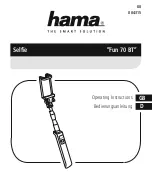Telink TLSR8232 BLE SDK Developer Handbook
AN-19112700-E1
106
Ver.1.0.0
Figure 3-42 Write Request/Write Response
3.4.3.9 Write Command
Please refer to
Core_v5.0
(Vol 3/Part F/3.4.5.3
) for details about “Write Command”.
The “Write Command” sent by Master specifies certain attHandle and attaches related
data. After the command is received, Slave will find the specified Attribute, determine
whether to process the data by using the callback function w or directly write the data into
corresponding Attribute Value depending on whether the callback function w is set by
user.
Slave won’t respond to Master with any information.
3.4.3.10 Handle Value Notification
Please refer to
Core_v5.0
(Vol 3/Part F/3.4.7.1) for details about
“Handle Value
Notification
”.
Figure 3-43 Handle Value Notification in BLE Spec
The figure above shows the format of
“Handle Value Notification” in BLE Spec.
5316 BLE SDK supplies an API for Handle Value Notification of an Attribute. By invoking
this API, user can push the notify data into bottom-layer BLE software FIFO. Stack will
push the data of software FIFO into hardware FIFO during the latest packet transfer
interval, and finally send the data out via RF.
ble_sts_t
bls_att_pushNotifyData
(
u16
handle,
u8
*p,
int
len);
“handle” is attHandle of Attribute, “p” is the head pointer of successive memory data to be
sent, while “len” specifies byte number of data to be sent. Since this API supports auto
packet disassembly, long notify data to be sent can be disassembled into multiple BLE
RF packets, large “len” is supported.
When Link Layer is in Conn state, generally data can be successfully pushed into
bottom-layer software FIFO by invoking this API. However, some special cases may


















